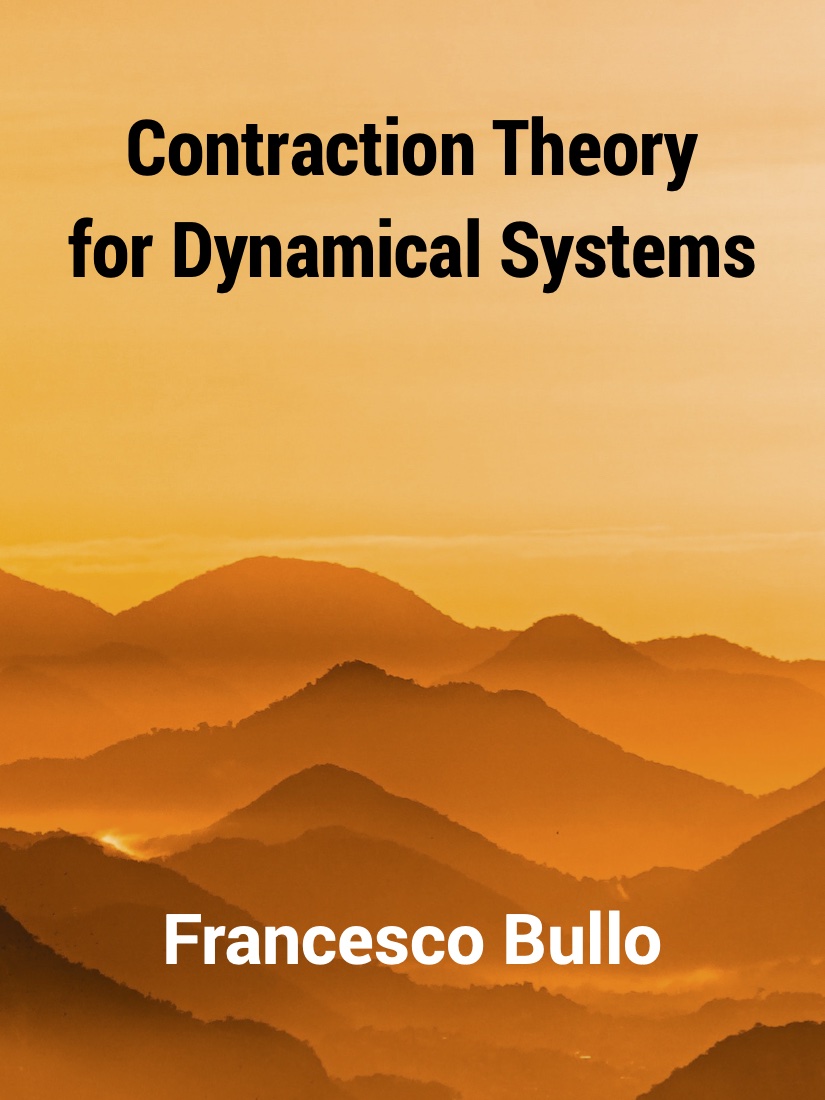Contraction Theory for Dynamical Systems
 |
Francesco BulloDepartment of Mechanical Engineering Edition 1.2, Aug 1, 2024 |
Abstract
These lecture notes provide a mathematical introduction to contraction theory for dynamical systems. Special emphasis is given to continuous-time differential equations arising in the study of network multi-agent systems, monotone dynamics, and semi-contracting systems. This document is version 1.2 on August 1, 2024.
These notes cover (i) the manifold properties of the induced norms and logarithmic norms of matrices, (ii) contracting dynamics over finite-dimensional vector spaces endowed with Euclidean and non-Euclidean norms, (iii) weakly-contracting dynamics and monotone dynamics, and (iv) semicontracting, perpendicularly and partially contracting systems. Numerous examples are presented in some detail, including Hopfield neural networks, systems in Lure’ form, interconnected contracting systems, gradient and primal dual flows of convex functions, Lotka-Volterra population dynamics, Daganzo traffic models, averaging flows, and diffusively-coupled synchronizing systems.
Book versions and purchase/download information
The book may be purchased or downloaded in the following versions:
printed paperback version [Amazon link], publishedby Kindle Direct Publishing (7inx10in, gray-scale, x + 210 pages), ISBN 979-8836646806
tablet version [PDF file], optimized for viewing on tablets (3x4 aspect ratio, color), freely downloadable from the book website
slide version [PDF file], that is, reformatted version suited for displaying on a classroom projector, freely downloadable from the book website
a solution manual (PDF format) for instructors at accredited institutions planning to use this book for a course. The manual contains solutions to the recommended exercises and is freely available upon request.
Solution manual
I repeat: the solution manual is freely available upon request ONLY for instructors at accredited institutions.
If you are not an instructor at an accredited institution, please do not email me in the hope of receiving a copy.
Additionally, the following documents are downloadable:
Almost all book figures, available with a Creative Commons Attribution-ShareAlike 4.0 International License (CC BY-SA 4.0): [tgz file]
All bibliographical entries: [bibtex file]
@Book{FB-CTDS,
author = {F. Bullo},
title = {Contraction Theory for Dynamical Systems},
year = 2024,
edition = {{1.2}},
publisher = {Kindle Direct Publishing},
ISBN = {979-8836646806},
url = {https://fbullo.github.io/ctds},
}
Tutorial slides and Youtube lectures
Tutorial slides: (PDF)
Minicourse on Contraction Theory: youtube lectures (12h in 6 lectures, with chapters, Sep 2023)
Copyright information
This book is intended for personal non-commercial use only: you may not use this material for commercial purposes and you may not copy and redistribute this material in any medium or format.
Why I decided to self-publish a print-on-demand book
There are several reasons why I decided to self-publish this book via the print-on-demand service by Kindle Direct Publishing (former Amazon CreateSpace). I appreciate the ability to:
retain the full copyrights of all the material,
make the document freely available online in multiple versions (see above),
retain direct anytime control over the paperback publication costs, retain a majority of the royalties after low fix costs, and set a low price,
update the book revision at any time (simply re-upload the PDF file, minimal turn-around time, no need for any permission, and never out-of-print), and
make available a high-quality paperback book through a broad distribution network.
As a combination of this flexibility, I typically polish and enrich the book every time I teach the course.
Similar arguments are presented in the write-up Why I Self-Publish My Mathematics Texts With Amazon by Robert Ghrist
History
Winter 2018: first time I taught the course
Fall 2020: second time I taught the course and first book draft
Spring 2022: third time and second book draft
Jul 1, 2022: first edition online, version 1.0
(Jul-Aug, 2022: document updated with corrected typos and minor additions)
March 2023: version 1.1
August 2024: version 1.2
Feedback
I am thankful for any feedback information, including suggestions, evaluations, error descriptions, or comments about teaching or research uses. Please email bullo at ucsb.edu